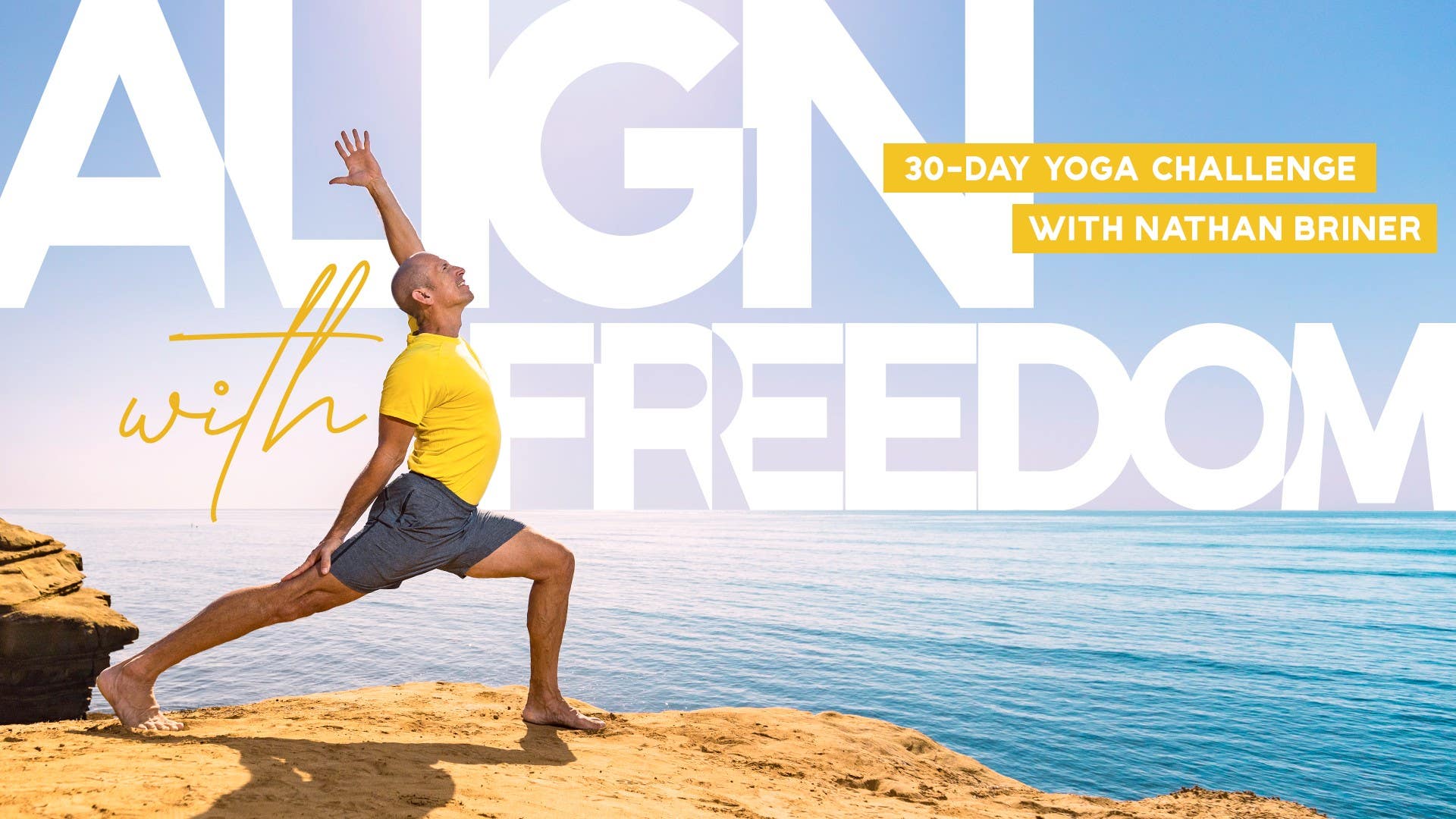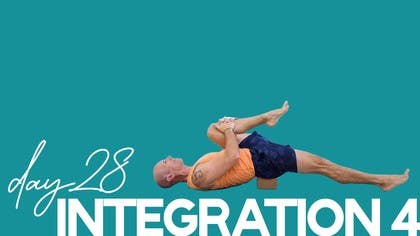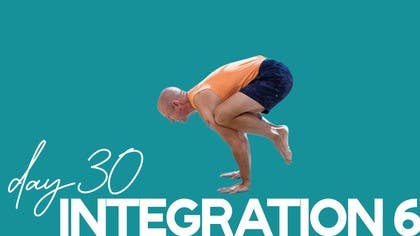Description
About This Video
Transcript
Read Full Transcript
Welcome in to day 29. Can you believe we only have two more practices together? We're in day five of integration, and I'll introduce new concepts today to help blossom even further in the meditation. In today's practice, we're going to be working on balancing the front half of the body with the back half of the body, and sometimes the sides, right and left, with the purpose of spreading the attention, not just segmentally through a limb, like the inner arm, inner leg action, but now through the entire body to really help spread all that awareness that we have further and further out. We are going to start in Tadasana today and do a few explorations to see what I'm getting at, kind of like we did on a few routines ago where we sat and then sat down and felt the difference. We're going to do that here in Tadasana. Standing with the feet together, we'll start by playing with the knees to see what you feel here.
I'm going to ask you to hyperextend the knees, not in any aggressive way, but just so you're pressing back the kneecaps and sort of overdoing there and see how your attention observes the physical sensations of that action. And what you may find is that the attention, even though I've said, look there, it just sort of stays there. It becomes such a gravitational pull that the awareness attention can't spread anywhere else. Okay, now let that go. Shake out your knees a little bit. And now we'll press from the hips to the heels and see if we can create a sense where the front side of the leg is equal in length and tension with the back side of the leg, bringing in some of our other practice ideas, sacrum and tailbone lightly down front of the pelvis up so that you could say that the container is equally around all portions of the leg. See what difference that has in your ability of the awareness to spread.
And let's take that idea now up to the spine. Relax legs for a moment. One more test. Lumbar spine a little dug in, so we're hyperextended. Maybe this is a little bit more obvious to feel. You see how the awareness just locks right into that lumbar? Let's create balance now.
Sacrum and tailbone down, equal front and back legs, and we're holding tadasana. And as you become more and more proficient at this, you find that awareness just spreading through everywhere in the body. Let's add to it. Arms out to the sides. We'll pause here. Then, without disturbing your tadasana, turn the arms up, and we'll take the arms overhead.
So go slow so that you feel you don't disturb that beautiful container you've created for your awareness. And in this mode of practicing asana, you feel the attention and awareness taking a vacation from the thinking mind as it spreads throughout the physical body. Then release down. Let's try a little bit more of a deeper pose, utkatasana. Find a nice, balanced tadasana.
And then we'll leave the arms out of it for just a moment and slowly bringing in your chair pose. Before we go too deep, feel the back of the leg there and from your buttock bone to the back of the knee, create a firmness of the hamstring, almost like it's a couch supporting your thighs. As you traverse a little further down, keep that support of the hamstring. So the top and the bottom leg are doing equal work. Arms out to the side.
And without arcing the back, we'll bring the arms wherever we can and still maintain an even balanced front and back of the body. And then come out. We'll try it again from and lifted arm tadasana. Arms up, nice balanced body. Breath in, utkatasana.
Press the heels to get that hamstring energy. Front and back body equal length. Hold your pose. And then release. We'll turn back to front again.
Next pose will be tree pose, adding a little bit more of a challenge to it as we try to find that balance. So I'm going to bring up the pant leg here, so I've got a little skin to stick to. Left leg up first. With the arms hanging, we're going to look to create balance. I drew your attention to the knee earlier.
I'll do it again now. There's a great tendency to hyperextend the knee here. So pressing down to the leg, I have to push the back of the leg down to the heel. That rolls the sacrum and tailbone down. Balances front and back body.
Take your time. And then without disturbing your tree pose, arms up and we're holding. So we come in touch with all parts of ourselves with this level of awareness and release. Second sign. Bringing the right leg up from a nice strong tadasana, we'll stick that right foot to the inner left leg.
Oh, maybe, maybe. Nope. One more time. There we go. All right. So I'm looking down to get my balance here.
Adjusting my leg, pushing down the back of the left leg. Sacrum and tailbone down. Find my balance. And then I take the arms. And as soon as I find that balance, everything clicks in.
And release. What I hope you find, the more you discover this balance, that the body just wants to expand more and more. Same with who we are. Our heart wants to expand as well. From here, we'll grab a strap to further add to our challenge.
This is something we've seen before. We'll grab the strap, feet together, mountain pose. We'll place the strap underneath the left foot, bring a bent knee up, and we're here. We're aiming for mountain pose, tadasana. From the back of your right hip, push down to the right heel.
And slowly, from that steadiness and balance, lifting up to the trunk, we'll bring the leg up. Press down from right buttock to right heel. Sacrum and tailbone down, front of the body lifting. Have you got the freedom to raise the right arm? The inward freedom we grow through this type of practice is being able to feel, like I say, all of our parts.
Not to make them go away, but to bring light to them. And they change or become more diffuse on their own. Release. Second side. Press down from left buttock to left heel, bringing up the right leg.
We'll bring up a bent leg, right hand holds the strap. Okay, and then from that balanced lifted pose, we'll extend the right leg. Sensing, front of the left leg, back of the left leg, front of the trunk, back of the trunk. Challenge lifting the arm. Spread the awareness, looking for any kinks in the pose that say we need to open here or support to balance.
And then release. Let's put the strap off to the side. And we'll turn toward the head of the mat. Feet together in mountain pose. Take a nice step back with the left leg, about three, three and a half feet for Parsvottanasana.
We'll take the awareness and attention and split it. One half down the front leg, one half down the back. We look to turn the hips squared forward. And then taking a little pause in this pose to bend the right knee. With the bent knee, you're going to push the roots of the toes, the ball of the foot down, and keep it well connected there.
Why are we doing this? So that when we push the leg straight from that foot connection, it doesn't want to hyperextend. So often in this pose, watch my knee, and then people go forward. So we're going to avoid that. Push the root of the foot, the toes down, and then slowly straightening the leg.
We'll take the arms up and extend forward. You could put your hands on the shin. If you have the freedom to take your hands to the floor, please do. Press down through both legs, lengthen your trunk. Take a breath in, exhale, bend the elbows, head and trunk down.
Here, observing the front and back of the front leg is their equal energy. And by energy, I mean how you're using that area, how you're lengthening, how you're reaching. How about the back leg? Inside edge, outside edge. One side short, one side long.
Inhale, straighten the trunk, come all the way up, and step forward. Let's do the second side. Right leg back. Toes turned out just slightly. Square the hips, take a breath in, we'll raise the arms.
And exhale, come forward. Hands on shins, hands to the floor, whatever you're needing. And remember, we push the balls of the feet, the roots of the toes into the mat. We're taking our time here, observing the way that we're using the legs, looking for support, and then bending the elbows, take the head and trunk down. Feeling the legs.
And then inhale, come up, straighten in the trunk, and all the way up, and step the feet forward. Let's take tadasana again and see how things are going, what new awarenesses are showing up for us. Stretch down the back of the leg, drawing up the front of the leg, front of the trunk, back of the trunk. So how is your awareness now? Are you noticing different areas that are at least calling for your attention, asking for an adjustment?
Maybe you can feel how to adjust, maybe you're not quite sure yet. We'll grow this together. Next pose we'll be taking is warrior pose, warrior one. We'll take about three, three and a half feet, arms out, turn the arms from the shoulders and raise the arms. We're going to be turning to the right, so left toes deeply in, right leg out, and warrior pose.
Remember how we take the sacrum and tailbone down from our last practice? Do that now, and then bending into the right leg. Now bring your attention to the length of the trunk, front side of the trunk and back side of the trunk. Is that lumbar over arched? Could you take the sacrum and tailbone down?
Warrior three, bring the arms forward and roll up off your left heel. Cross thumb on thumb and palms together. Bring your body weight forward, step in, and we're going to raise the leg up, back leg up, left leg. Warrior two, warrior three. Here, mountain pose with the trunk and lifted leg.
Balanced energy, standing leg. And touchdown, arms up, release to center. Second side, arms out, palms up from the shoulders. Now arms up, right toes in, left leg out, second side. Sacrum and tailbone down, bending into the left knee.
Observe the length of the front body. Observe the length of your back body. What's calling for your attention? Feeling these things is how you grow in your yoga practice. We'll bring the arms forward, cross thumb on thumb, palms together, turn up off your right heel.
Lean the trunk forward, reach and step in, ready, set, warrior three. So once again, we aim for the trunk and lifted leg to be like Tadasana. Balanced energy in the standing leg. And then graceful contact. Come out, spread the arms.
Let's find Tadasana again. Ah, recheck. Is there more clarity? Is there less? All right, so we're looking to see what changes.
Did it go in the right direction? Did it go in the wrong direction? Can you see how we can translate that into the world around us? All right, stepping to the front of the mat, feet together, let's move a little, arms up, inhale. Half Uttanasana, exhale, hands on shins, nice long straight spine, and then fold.
Hands to floor, step back. Breath in, plank pose, exhale, Chaturanga. Up dog, inhale. Down dog, exhale. Come into a plank.
We're aiming at side plank here. Turn onto the outer right foot, stack the left leg, holding here. And then in this pose, mountain pose on its side. You can see that, yes? Nice strong legs, top arm up.
Anywhere you need to adjust to create that balance. And releasing down, dog pose. Plank pose. Turn the outer left foot to the mat, stack, right leg on left. Turn, sacrum and tailbone down, front pelvis up, chest open.
Yes, much harder than Tadasana standing, but we still look for that balance. To plank pose. Let's find a dog pose. This is our restoration, so if you need a child's pose, please do take it. From your down dog, come down to knees.
Walk your feet forward. Come into a sitting position. Core work not quite finished. We're going to hit Navasana, boat pose. We'll start with the feet together, legs bent.
Leaning back a little, fingertips forward, finding the balance. Little adjustment there. Now, front side of the trunk, back side of the trunk, nice long even body. Bring the legs up and extend. I'm going to give you the full challenge here today.
Arms, squeeze the legs together and lengthen them. Strong knees. And drop the feet, rest. One, two, three, here we go. Back on the hips again, nice tall spine, balanced body.
Bring the knees up, extend those legs. And arms. And rest. So it's like we take an action figure from Tadasana and we bend it into these shapes without losing Tadasana, the balance of that pose. Last one, leaning back, fingertips for balance, legs up, spread those toes.
And arms. Holding, breathing, and rest. Navasana, boat pose. Grab a folded blanket. Now let's have a strap nearby for this seated pose.
I'm going to sit up on one folded blanket for what is known as bada konasana, bound to angled pose. We'll bring the feet in, knees out wide. And the strap, by the way, heels in nice and close to the groin for this. The strap, we're going to take underneath the pinky edges of the feet. We'll hold the strap as close as we can to the feet.
And we're creating Tadasana trunk here. It's a nice release too after Navasana, boat pose. Please draw your attention to your sacrum. That's the hard bony plate behind your pelvis. By pulling on the strap, and I'm going to pump this action a little bit so you can see what I mean by forward, we're trying to draw the sacral plate deeper in.
Not a tuck of the tailbone, not an arch of the lower back, but the sacrum and tailbone. Straight in. The result of that is it lifts the front of the spine up. So we're consistent with what we're attempting to create in each of these poses. Now we have hold of the feet.
Sacrum in. Spine up. Energy of the legs is soft. I'm not attempting to drive my knees into the ground. In fact, the more I'm calm here, the legs give up the motion on their own.
Widen and broaden the chest. Soften the shoulders. Let the attention become absorbed or subsumed in your asana. Moving meditation. If you'd like to close your eyes, this is a nice time to do it.
Just see what you're feeling. You could sense that the trunk is leaning a little too forward. That's where mine was a moment ago. I came back. Now there's more of that pure symmetrical lift from front and back sides.
Okay, release. We'll take the strap away. I'm going to put the blanket away to trade out for a block. Next pose is Virasana. The block will go between the heels and underneath the sitting bones.
Feet in, just to the outsides of the legs. See how I adjust the knees by pulling the skin forward. Skin of the buttocks, you know how we've done this. Ah, there it is. You can turn the palms up and just finding the steady state of balance in this pose.
Because of the way we organize our lives, we are so driven by doing. If I do this pose, I'll get to that awareness and then I'll do something with the awareness. But the goal here is just to reveal that aware part of being and let it do its magic. You sort of become digested into the awareness. Interlace your fingers.
Extend your arms. Bring the arms up. Note that tendency to over-dig the lumbar spine. You have to keep the sacrum and tailbone a little anchored, not tucked under like the deeper back bends, but just anchored. And then release. Let go.
One more seated pose is dandasana, staff pose. One more time, blanket please. Sitting up on that blanket. Now, we'll reach underneath one leg. Turn the underside of the leg out from hamstring, inside out a little.
Pull the skin and muscle back of the buttock. Second leg, we reach under, pull the hamstring just slightly out and pull the skin and muscle back. Fingertips alongside us on the blanket. Legs have energy. We're reaching from the inner groin to the inner arch.
And again, I'm looking for the pose itself to support the body in such a way that awareness simply dissipates through the entire physical experience. And you know, today maybe it dissipates from one side of the chest to the other. But that's why we call it a practice, isn't it? To continue to grow. And then release.
Blanket away, we're playing musical props here. I'm going to turn around onto the back and lie down for bridge pose. Rest your arms by your sides, feet about hip width apart. Lift your hips. You can either grab hold of the mat or if you understand how to roll the shoulders, you can roll the shoulders freely.
Go on lifting up. Now we know that sacrum and tailbone tuck. We can try to bring the hands underneath the buttocks for support. If the wrists and arms allow and you'd like to come under, I'll come up onto my tippy toes to really take those hands under. And then heels down as long as your wrists allow.
We'll hold here, lifting the chest. You can come up on your tippy toes one more time, release the hands, release the hips, and we're right into Shavasana. We'll start by allowing the lower back to relax after the back bend into the floor. One leg at a time. Extend out and extend out.
Allow the energy of the legs to release and relax. And as I've been mentioning and hinting at throughout our practices together, if we can balance the limbs, front and sides of the trunk, front back sides, there comes such a quietness to the nervous system because it's not being asked to look here, there, everywhere. And that aware presence is revealed. You could say that this is an expression of dhyana in the eight limbs of yoga. This is a great opportunity for you to stay a little longer in your Shavasana, letting go, relaxing.
If it's time for you to come out, you can rest your hands and your tummy. One at a time, bend your knees and turn to your side. Support your head, find a comfortable position for a few breaths. And then gently press up to sitting. I would love to hear how you felt in that practice, what you were able to notice and what you had difficulty noticing.
Please leave a comment if you can, and I will definitely get back to you. Looking forward to our final practice together. This has been an amazing time. I will see you in the next practice, number 30. Have a tremendous day. Namaste.
Align with Freedom: 30-Day Yoga Challenge
Comments
You need to be a subscriber to post a comment.
Please Log In or Create an Account to start your free trial.




















